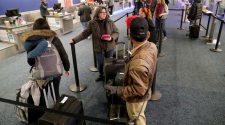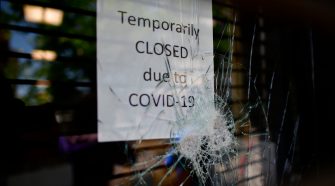These pronouncements and pledges have turned out, again and again, to be a description of the administration’s aspirational response to the pandemic, not the one doctors, nurses and stricken families are reporting from the front.
That is where emergency responders and hospitals are dangerously low on protective gear, and where widespread, rapid testing for the virus in retail parking lots is not, in fact, a reality. Where millions of small-business owners are struggling to get federal assistance they need to stave off collapse and where millions of people are newly unemployed and fearing ruin.
“LIGHT AT THE END OF THE TUNNEL!” Trump tweeted at the start of the week, without elaborating on the source of that optimism. The president had picked the Easter holiday Sunday as his target to reopen the country during a briefing two weeks ago, acknowledging days later that his “beautiful timeline” was “aspirational.”
“I’m a cheerleader for the country,” Trump has said when asked why he has played down the threat and his sunnier predictions have not come true.
While all crisis leaders have to chart a delicate course between comforting the nation and providing reliable information to its citizens, the president and his top political aides have repeatedly used the nationally televised briefings to describe efforts and actions that have not panned out.
Trump stood in the White House Rose Garden nearly four weeks ago with top supermarket and pharmacy executives to announce a Google-powered testing system that Americans could access in store parking lots from the convenience of their automobiles. Such a system — which would be a critical step in the effort to assess the virus’s impact and ultimately to reopen the country — remains in its earliest stages.
At hospitals, the shortage of N95 respirators and other protective gear has been so acute that administrators are trying to get them from auto-body shops and nail salons, according to a report released Monday by the Department of Health and Human Services’ Inspector General. The report said one hospital is making its own hand sanitizer by mixing alcohol from a nearby distillery with the gel typically used for ultrasound exams.
The president signed a $2 trillion stimulus bill March 27 to great fanfare, including direct payments to American families. But some will not receive their checks until September, if at all.
When Navy hospital ships steamed into New York Harbor and the Port of Los Angeles, the White House touted them as symbols of the “whole of government” response to the pandemic. But they have sat there mostly empty, because they were not taking patients infected with the virus. One of the ships, the USNS Comfort, began taking covid-19 patients this week, after sitting alongside New York for days with nearly all of its 1,000 beds unfilled.
Jeffrey P. Koplan, former director of the Centers for Disease Control and Prevention, said the missteps and unfulfilled promises from the White House reflect a failure of crisis communication, above all.
Trump went from dismissing the severity of the outbreak — vowing in February that the virus would “disappear . . . like a miracle” and accusing Democrats of wielding the crisis as “their new hoax” — to claiming he “felt it was a pandemic long before it was called a pandemic.”
Since then, Trump has misstated the scope of travel restrictions and made false claims about his use of the Defense Production Act. He has mischaracterized the availability of lifesaving breathing devices and cast doubt on whether doctors need the volume of supplies they are requesting.
All the while, he has demanded that governors “appreciate” his work, as his reelection campaign splices their words of praise into advertising spots.
“We will WIN this war,” his campaign promised in an email to supporters Friday.
But victory requires honesty, Koplan said.
“The public needs a trusted purveyor of information about the outbreak,” he said. Instead, he warned, members of the administration are “resorting out of desperation to wishful thinking.”
The task force’s top medical advisers periodically inject more sobering facts into the inflated assessments and predictions of the president and his aides. But that has led to behind-the-scenes clashes between health experts and members of the task force.
Judd Deere, a White House spokesman, declined to respond to specific questions about the president’s unmet promises and the confusion left in their wake, instead providing a list of 120 “actions which this administration has taken to protect the health and safety of the American people,” saying, “I hope you print every single one.”
They vary from imposing travel restrictions to taking executive action aimed at preventing price gouging. But they also include such tasks as speaking to the leaders of other Group of 20 nations and creating a website to keep Americans informed about the virus. Others, such as cutting red tape to expand testing and accelerating the development of therapeutic drugs, have not yet come to fruition.
Doubt about the president’s pronouncements is pervasive, in diverse parts of the country, reaching from emergency operation centers to hospitals to the halls of Congress.
Grim humor is how a medical supply manager in one Southern state has responded to the dire shortages of personal protective equipment, or PPE. Every morning since the president promised Americans last month they would be able to “drive up and be swabbed without having to leave your car,” the state official no longer offers a traditional “Hello,” according to a Federal Emergency Management Agency employee embedded in the office, who spoke on the condition of anonymity and asked that his specific location not be identified for fear of retribution.
Her new greeting comes in the form of a wry query: “Where are my swabs and PPE?”
Drive-up testing is still not widely available, and it is not true, as Trump promised on March 7, that, “Anybody that needs a test can have a test.”
While the United States has now performed more tests than nations such as South Korea, where the practice was adopted early and aggressively, the country still lags behind other nations on a per capita basis. Many Americans with coronavirus symptoms who aren’t sick enough to require hospitalization are not being checked, and some are probably dying without being counted as virus-related casualties, according to public health experts.
There are also wide disparities between states on the number of tests being administered, and even how those results are reported.
Nor was it the case, as the president said in remarks on March 13, that Google was building a website to facilitate widespread testing. “Google has 1,700 engineers working on this right now,” he said falsely. Vice President Pence sought to clarify the details the next day, telling reporters the website would be put to use in “areas that have been deeply impacted — Washington state, California, New York.”
That was not true, either. Verily, a health subsidiary of Google’s parent company, was developing a pilot project first rolled out in two counties in the San Francisco Bay area and since extended to three more.
Even in one of the original locations, San Mateo County, drive-up testing is not available countywide, according to Preston Merchant, a health department spokesman. He said county officials learned the details of the project, including that Verily was a Google-affiliated venture, after the president’s remarks. Each site can process 200 appointments a day, according to a Verily spokesperson.
Elsewhere, the administration’s promise of widespread tests has required physicians to go to great lengths to clarify standards for their patients.
Margo Karsten, who oversees 13 facilities in five states as president of Banner Health’s western region, said health-care providers are “over-communicating why we’re triaging” as they face mounting inquiries about tests.
“I would request that we really trust the health-care leaders,” she said.
Concern about reliable information extends beyond Trump’s words. For weeks now, Kavita Patel, an internist in Washington, D.C., has been turning to the British health ministry’s website instead of the information put out by the CDC.
“This came to a head when the CDC started putting out guidance about how to use bandannas in a health-care setting,” said Patel, who previously served as a senior adviser in the Obama administration. “It felt like this couldn’t possibly be the best evidence.”
Trump has placed FEMA in charge of coordinating the administration’s response, but FEMA Administrator Peter T. Gaynor rarely speaks to the news media and appears infrequently at task force briefings. The agency functions more like the procurement wing of the White House than an emergency management agency leading a crisis response, according to multiple lawmakers briefed on the administration’s efforts.
“Now that FEMA has been asked to assist, the agency has made progress in procuring these additional items on behalf of the federal government for provision to the states,” said Daniel Kaniewski, who stepped down as the agency’s deputy administrator earlier this year. “Of course that took some time, but given the challenges FEMA faced right out of the gate, this is real progress.”
Allison Arwady, Chicago’s public health commissioner, said watching the federal government seek to explain disruptions to the supply chain recalled her prior work combating Ebola in Liberia and MERS in Saudi Arabia.
“Americans are not used to scarcity,” she said. “The federal response needs to be serious.”
But even federal lawmakers struggle to wrap their heads around the administration’s approach to allocating scarce resources.
“I and my office have spent the last five days trying to figure out how the federal government is interacting with the critical medical supply chain, and five days later, I am no closer to finding out an answer,” said Sen. Chris Murphy (D-Conn.). “In part because we’re getting inconsistent messages depending on who we talk to, and also because the administration seems to have made a decision to play a short center field. They’re halfway involved in the market, but not all the way, which frankly seems to be adding more chaos than had they just stayed completely out.”
Craig Stevens, a former George W. Bush administration spokesman who served as communications director to Surgeon General Richard H. Carmona, defended the president’s approach, saying he was responding to real-time demands for information heightened by social media — factors not present during previous pandemics.
“He said himself he wants to give people hope,” Stevens said.
















